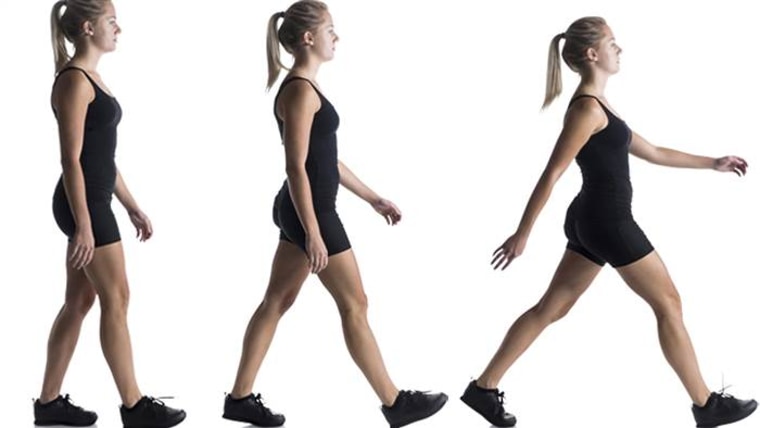Feeling a bit intimidated by people boasting about their impressive step counts on Facebook or in real life? Well, don't get too discouraged by your 5,000 daily steps — a study led by the American Cancer Society found that even short walks may help you live longer.
The American Heart Association recommends adults get at least 30 minutes of moderate-intensity aerobic activity, at least five days a week. Yet the recent study found that people who walked, but didn't meet those recommended guidelines, still had a lower mortality risk.
The bottom line? Start walking — even if it's just for 10 or 20 minutes a day. And, if you'd like to turn that short walk into an effective, calorie-burning workout — it just takes a few simple tweaks.
Researchers have found that as we walk, our nervous systems do real-time calculations to figure out which step length and speed expend the least amount of energy, according to a 2015 study in Current Biology. And when it comes to saving energy, our bodies are downright thrifty.
“Most of us like to be lazy at least some of the time,” explained study co-author Max Donelan, a professor of biomedical physiology and kinesiology at Simon Fraser University in British Columbia. “We make conscious choices to sit when we could have stood up, to watch TV instead of going for a long walk. Laziness is also true of the nervous system. It’s acting to make our movements as energetically cheap as it possibly can. It will go for even the smallest of savings, fine tuning our movements to save just 5%.”

Though it’s long been known that humans evolved to walk efficiently, it wasn’t clear — until now — that the human body is constantly taking in data and adjusting gaits to make us energy efficient.
To conduct the study, Donelan and his colleagues fitted a group of volunteers with “robotic exoskeletons,” contraptions that fit over the limbs and can be adjusted to make it easier or harder to walk by making it more difficult to move the knee joint.
After determining each volunteer’s preferred step length and walking speed, the researchers then made it harder for each participant to move that way. Within a short time each had adapted their movement to be energy efficient — and they did so more quickly than anyone could have done consciously.
“The nervous system is working behind the scenes seeking the cheapest way to move,” Donelan said. “It’s adapting how we turn our muscles on and off and how long and fast the steps we take are in order to make things as economical and cheap as possible."
Our bodies aren't trying to ruin our fitness goals out of spite. They're hard-wired not to burn calories for a very smart reason. We evolved to walk as efficiently as possible as a survival strategy, according to David Carrier, a professor in the biology department at the University of Utah.
“It makes sense to be lazy,” Carrier said. “If you’re not sure there’s going to be food a week from now, you don’t want to be wasting any energy.”
This study doesn't mean you should throw in the towel and lumber over to the sofa to watch more TV.
“Walking at your preferred speed is a whole lot better than sitting, but you still have to think of it as low-level exercise,” Carrier said.
Experts say it’s also possible to work around your body’s innate laziness and burn more calories, but that takes conscious choices. Here are three tips to help you:
1. Go out of your comfort zone.
If we walk in a way that pushes us out of our comfort zones, we’ll burn more calories per mile.
Choose a stride length that isn’t too easy or comfortable, advised Manoj Srinivasan, a professor of mechanical engineering and head of the movement lab at Ohio State University.
“If it doesn’t feel natural, it probably costs more energy,” Srinivasan said. “So you might vary the length of your steps or just walk faster than is comfortable. If you’re on a bike you might choose a gear that feels harder to peddle at.”
2. Speed up!
Simply pumping up speed alone can burn a lot more calories. “As you increase the speed, the cost [in calories burned] goes up and the efficiency goes down. You just have to push till you’re breathing hard," said Carrier.
The best way to overcome your body’s attempts at efficiency are varying your routine and modifying your movement so that your heart rate increases and you’re a little out of breath, said Dr. Vonda Wright, an orthopedic surgeon and medical director at the University of Pittsburgh Medical Center’s Lemieux Sports Complex.
3. Mix it up.
“When I’m teaching a new exercise I tell people that the body is a dynamic exercise machine,” Wright said. “In two weeks it’s adapted and not burning as many calories as it was in the beginning. So you have to mix it up and challenge your body. If you’re walking to work you’re doing the right thing, but if you’re taking the same route, the body becomes accustomed to that. It’s the lazy way. You can change that if you take a different route or consciously decide to walk faster.”
If you’re jogging regularly, that’s good. “But it shouldn’t be one long slow jog,” she added. “Every once in a while, run faster for about three minutes. That will ramp up your heart rate and confuse the body. It will reset at a different lazy, a better lazy, if you will.”